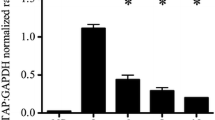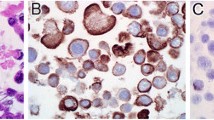Abstract
Lingual antimicrobial peptide (LAP) and tracheal antimicrobial peptide (TAP) are two important β-defensins of antimicrobial peptide family, which are evolutionarily conserved effector molecules of the innate immune response. Although known to be sensitive to pathogenic challenge, the control of their expression remains unclear. Both LAP and TAP genes showed constitutive and inducible expression in bovine mammary epithelial tissues, and the aim of this study was to investigate the mechanisms underlying their expression and regulation. Reporter plasmids fused with 5′ regions of the two gene promoter regions were constructed and transiently transfected into a bovine mammary epithelial (BME) cell line. Initial serial deletion of the promoter regions from both genes identified two positive regulatory elements within the 1 kb regions upstream the transcription start sites, which co-operatively contribute to LAP and TAP gene expression. Further luciferase reporter assays revealed that an enhancer and a 61-bp region proximal to both genes are important for basal expression and regulation of transcription. Electrophoretic mobility shift assays (EMSA) indicated the involvement of the Oct-1 protein-DNA complex in regulating the promoter activity, which was confirmed by super shift EMSA with Oct-1 antibody and by knockdown of Oct-1 with small interfering RNA. The Oct-1 binding motif was also shown to be responsive to phorbol 12-myristate 13-acetate but not LPS stimulation. The results from this study clearly demonstrate the involvement of the Oct-1 transcription factor in the regulation of LAP and TAP expression.







Similar content being viewed by others
References
Bhat R, Weaver JA, Sterling KM, Bresnick E (1996) Nuclear transcription factor Oct-1 binds to the 5′-upstream region of CYP1A1 and negatively regulates its expression. Int J Biochem Cell Biol 28:217–227
Bradley A (2002) Bovine mastitis: an evolving disease. Vet J 164:116–128
Cartharius K, Frech K, Grote K, Klocke B, Haltmeier M, Klingenhoff A, Frisch M, Bayerlein M, Werner T (2005) MatInspector and beyond: promoter analysis based on transcription factor binding sites. Bioinformatics 21(13):2933–2942
Chapwanya A, Meade KG, Doherty ML, Callanan JJ, Mee JF, O'Farrelly C (2009) Histopathological and molecular evaluation of Holstein–Friesian cows postpartum: toward an improved understanding of uterine innate immunity. Theriogenology 71:1396–1407
Cormican P, Meade KG, Cahalane S, Narciandi F, Chapwanya A, Lloyd AT, O'Farrelly C (2008) Evolution, expression and effectiveness in a cluster of novel bovine beta-defensins. Immunogenetics 60:147–156
Davies D, Meade KG, Herath S, Eckersall PD, Gonzalez D, White JO, Conlan RS, O'Farrelly C, Sheldon IM (2008) Toll-like receptor and antimicrobial peptide expression in the bovine endometrium. Reprod Biol Endocrinol 6:53
dela Paz NG, Simeonidis S, Leo C, Rose DW, Collins T (2007) Regulation of NF-kappaB-dependent gene expression by the POU domain transcription factor Oct-1. J Biol Chem 282:8424–8434
Diamond G, Zasloff M, Eck H, Brasseur M, Maloy WL, Bevins CL (1991) Tracheal antimicrobial peptide, a cysteine-rich peptide from mammalian tracheal mucosa: peptide isolation and cloning of a cDNA. Proc Natl Acad Sci U S A 88:3952–3956
Diamond G, Jones DE, Bevins CL (1993) Airway epithelial cells are the site of expression of a mammalian antimicrobial peptide gene. Proc Natl Acad Sci U S A 90:4596–4600
Diamond G, Kaiser V, Rhodes J, Russell JP, Bevins CL (2000) Transcriptional regulation of beta-defensin gene expression in tracheal epithelial cells. Infect Immun 68:113–119
Durr M, Peschel A (2002) Chemokines meet defensins: the merging concepts of chemoattractants and antimicrobial peptides in host defense. Infect Immun 70:6515–6517
Ganz T (2003) Defensins: antimicrobial peptides of innate immunity. Nat Rev Immunol 3:710–720
Garcia JR, Jaumann F, Schulz S, Krause A, Rodriguez-Jimenez J, Forssmann U, Adermann K, Kluver E, Vogelmeier C, Becker D, Hedrich R, Forssmann WG, Bals R (2001) Identification of a novel, multifunctional beta-defensin (human beta-defensin 3) with specific antimicrobial activity. Its interaction with plasma membranes of Xenopus oocytes and the induction of macrophage chemoattraction. Cell Tissue Res 306:257–264
Goldammer T, Zerbe H, Molenaar A, Schuberth HJ, Brunner RM, Kata SR, Seyfert HM (2004) Mastitis increases mammary mRNA abundance of beta-defensin 5, toll-like-receptor 2 (TLR2), and TLR4 but not TLR9 in cattle. Clin Diagn Lab Immunol 11:174–185
He X, Rosenfeld MG (1991) Mechanisms of complex transcriptional regulation: implications for brain development. Neuron 7:183–196
Hoffmann E, Dittrich-Breiholz O, Holtmann H, Kracht M (2002) Multiple control of interleukin-8 gene expression. J Leukoc Biol 72:847–855
Isobe N, Nakamura J, Nakano H, Yoshimura Y (2009) Existence of functional lingual antimicrobial peptide in bovine milk. J Dairy Sci 92:2691–2695
Kaiser V, Diamond G (2000) Expression of mammalian defensin genes. J Leukoc Biol 68:779–784
Lauzon K et al (2005) Antioxidants to prevent bovine neutrophil-induced mammary epithelial cell damage. J Dairy Sci 88(12):4295–4303
Lebkowski JS, McNally MA, Okarma TB, Lerch LB (1987) Inducible gene expression from multiple promoters by the tumor-promoting agent, PMA. Nucleic Acids Res 15:9043–9055
Levine M, Tjian R (2003) Transcription regulation and animal diversity. Nature 424:147–151
Liu S, Shi X, Bauer I, Gunther J, Seyfert HM (2011) Lingual antimicrobial peptide and IL-8 expression are oppositely regulated by the antagonistic effects of NF-kappaB p65 and C/EBPbeta in mammary epithelial cells. Mol Immunol 48:895–908
Luenser K, Ludwig A (2005) Variability and evolution of bovine beta-defensin genes. Genes Immun 6:115–122
Malakooti J, Sandoval R, Amin MR, Clark J, Dudeja PK, Ramaswamy K (2006) Transcriptional stimulation of the human NHE3 promoter activity by PMA: PKC independence and involvement of the transcription factor EGR-1. Biochem J 396:327–336
Mitchell PJ, Tjian R (1989) Transcriptional regulation in mammalian cells by sequence-specific DNA binding proteins. Science 245:371–378
Mukaida N, Mahe Y, Matsushima K (1990) Cooperative interaction of nuclear factor-kappa B- and cis-regulatory enhancer binding protein-like factor binding elements in activating the interleukin-8 gene by pro-inflammatory cytokines. J Biol Chem 265:21128–21133
Oliver SP, Mitchell BA (1983) Intramammary infections in primigravid heifers near parturition. J Dairy Sci 66:1180–1183
Pankratova EV, Polanovsky OL (1998) Oct-1 promoter region contains octamer sites and TAAT motifs recognized by Oct proteins. FEBS Lett 426:81–85
Roosen S, Exner K, Paul S, Schroder JM, Kalm E, Looft C (2004) Bovine beta-defensins: identification and characterization of novel bovine beta-defensin genes and their expression in mammary gland tissue. Mamm Genome 15:834–842
Schonwetter BS, Stolzenberg ED, Zasloff MA (1995) Epithelial antibiotics induced at sites of inflammation. Science 267:1645–1648
Sibbet GJ, Cuthill S, Campo MS (1995) The enhancer in the long control region of human papillomavirus type 16 is up-regulated by PEF-1 and down-regulated by Oct-1. J Virol 69:4006–4011
Stolzenberg ED, Anderson GM, Ackermann MR, Whitlock RH, Zasloff M (1997) Epithelial antibiotic induced in states of disease. Proc Natl Acad Sci U S A 94:8686–8690
Struhl K (1991) Mechanisms for diversity in gene expression patterns. Neuron 7:177–181
Sturm RA, Das G, Herr W (1988) The ubiquitous octamer-binding protein Oct-1 contains a POU domain with a homeo box subdomain. Genes Dev 2:1582–1599
Swanson K, Gorodetsky S, Good L, Davis S, Musgrave D, Stelwagen K, Farr V, Molenaar A (2004) Expression of a beta-defensin mRNA, lingual antimicrobial peptide, in bovine mammary epithelial tissue is induced by mastitis. Infect Immun 72:7311–7314
Wu GD, Lai EJ, Huang N, Wen X (1997) Oct-1 and CCAAT/enhancer-binding protein (C/EBP) bind to overlapping elements within the interleukin-8 promoter. The role of Oct-1 as a transcriptional repressor. J Biol Chem 272:2396–2403
Yang D, Chertov O, Bykovskaia SN, Chen Q, Buffo MJ, Shogan J, Anderson M, Schroder JM, Wang JM, Howard OM, Oppenheim JJ (1999) Beta-defensins: linking innate and adaptive immunity through dendritic and T cell CCR6. Science 286:525–528
Zavizion B, van Duffelen M, Schaeffer W, Politis I (1996a) Establishment and characterization of a bovine mammary epithelial cell line with unique properties. In Vitro Cell Dev Biol Anim 32:138–148
Zavizion B, van Duffelen M, Schaeffer W, Politis I (1996b) Establishment and characterization of a bovine mammary myoepithelial cell line. In Vitro Cell Dev Biol Anim 32:149–158
Zhang H, Shepherd AT, Eason DD, Wei S, Diaz JI, Djeu JY, Wu GD, Blanck G (1999) Retinoblastoma protein expression leads to reduced Oct-1 DNA binding activity and enhances interleukin-8 expression. Cell Growth Differ 10:457–465
Acknowledgments
We appreciate the kind gift of LAP and TAP gene sequences, provided by Dr. Gill Diamond, New Jersey Medical School, Newark, NJ. This work was supported in part by the Kansas State University Agricultural Experiment Station.
Author information
Authors and Affiliations
Corresponding author
Rights and permissions
About this article
Cite this article
Yang, J., Sang, Y., Meade, K.G. et al. The role of oct-1 in the regulation of tracheal antimicrobial peptide (TAP) and lingual antimicrobial peptide (LAP) expression in bovine mammary epithelial cells. Immunogenetics 63, 715–725 (2011). https://doi.org/10.1007/s00251-011-0547-3
Received:
Accepted:
Published:
Issue Date:
DOI: https://doi.org/10.1007/s00251-011-0547-3




